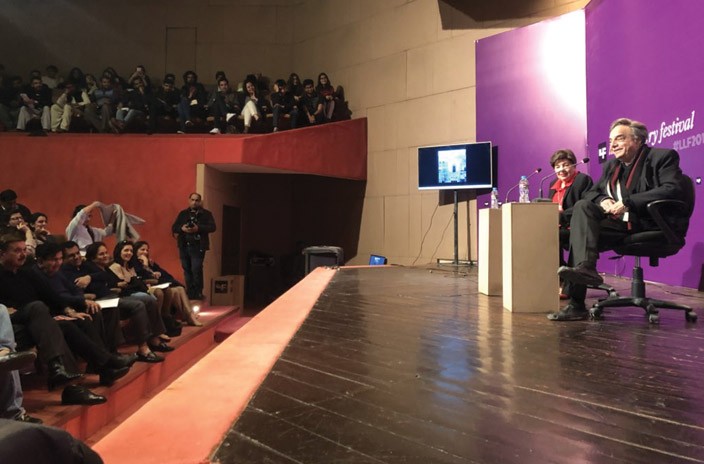
Two intellectually stimulating sessions at the recently concluded LLF ’19, placed emphasis on the city of Lahore and beyond

Since I have been back in Lahore to do fieldwork for my PhD dissertation, I have been to different nooks and corners of the city -- to get to know the city better. The 7th Lahore Literature Festival 2019 was such an occasion where I got to attend a couple of informative sessions on the city of Lahore and beyond.
On the second day of the festival, there was an interesting session, titled ‘My Lahore: A journey through the past and present of the cultural capital of Pakistan.’ Parveen Kennedy and Nayyar Ali Dada, through their relaxed presence on stage, brought forth the contrast between "sureela Lahore" (melodious/musical Lahore) and "be sura Lahore" (un-musical/noisy Lahore). Through a collage of pictures, Dada showed the audience what used to be a melodious/musical city, defined by the magnificent Mughal-era buildings and colonial architecture. He related how the city took in its fold those buildings, like the magnificent Badshahi Masjid and Masjid Wazir Khan, before the British marked the urban space with their own sense of architecture. However, realising the importance of the indigenous style buildings, the genius of Sir Ganga Ram gave Lahore the famous buildings including the General Post Office (GPO) and Lahore Museum.
Dada, an eminent architect, also shared some jokes and anecdotes with the audience seated inside the hall. He recalled how once the owner of Shahdin Manzil wanted him to replace the building with a modern-style plaza. The owner could not be persuaded to let the great architectural piece be until he came to know that American President Jimmy Carter and his wife had liked the building. Thus, the intervention of a foreigner saved the white building on the side of the Charing Cross.
A Power Point presentation was a treat to the eyes, with classical music accompanying the visually tempting slides. Kennedy and Dada seemed to be overcome by nostalgia, all praise for how much freedom the city was allowed back in the day (until the 1970s) -- be it the freedom to go to places of worship or the freedom to go dancing. The duo did not say much about the "be sura" Lahore except through a picture of cars and other vehicles parked on the Mall in front of the Panorama Centre.
There was no room left for the audience to ask any questions. The session was interesting and entertaining; and everybody enjoyed the smooth talk except when we heard someone snoring on full volume, or an occasional giggle and a whisper from among the crowd. The fact that the co-host, Kennedy, a white lady, could speak Urdu effortlessly, and eloquently, struck a chord with the audience.
My interest in the city took me to another session, ‘A City in Fiction: Capturing Lahore’s stories and streets, violence and revolts, cosmopolitanism and provincialism,’ which had author and critic Muneeza Shamsie, Roopa Farooki, and Osama Siddique as panelists.
Claire Chambers moderated this session well, giving all the panelists the opportunity to express their views. Eventually, they talked about the stories and books that shaped how they imagined and experienced the city, while delving into their sense of belonging and displacement, and how it all went into shaping them as writers. The city did not leave them, they seemed to agree, even if they left it, setting down in the far-off lands.
Siddique seemed to be more in touch with the city’s landscape, and his relationship with the writings on the city. For one, he spoke of how a certain tree in the Urdu novel Raja Gidh by Bano Qudsia had influenced his visits to probably the most beautiful park in the whole city. Even now when he is in the garden he is conscious of the tree under which the protagonist Qayyum and Seemi used to meet at night, the tree which was also an abode of jinns.
The Q&A segment was intellectually stimulating and engaging, with the panelists and the audience sharing their experiences of -- and relationship with -- the city. Two questions in particular stirred a debate. Firstly, why did they choose to write in English language? Siddique, in a lighter tone, dismissed the impression that the questioner was "spoiling the party," saying there was one party going on. There could (and should be) be as many as 20 parties and all had the right to write and express their views.
To this, Farooki said she had certain experiences, and had the right to share her stories, even if her work was framed within a western literary cannon.
The second question, why did they write on/about the "colonial city"? That is, why did they talk/write only about spaces, say, the Mall, excluding the more local and diverse city experiences such as the food culture of Androon (Inner/Old) Shehr. Again, Siddique, picking up his debut novel, Snuffing Out the Moon from the table, said that it had both the colonial and the postcolonial in it. The piece of fiction, he added, spans over centuries and there are parts of the book where he writes about things like the food, the pigeons on the roofs, rooftop romances, and the predators/perverts lurking in the corners.
The same day, there was another session on another city from another continent: ‘A Line in the River: Khartoum, City of Memory,’ a pleasant addition to the menu of the festival. It was so good to hear the author, Jamal Mahjoub, to have a conversation with Amna Rizwan Ali and share his memories of the city and how the two influenced each other, as if the stories of the city and his own flow into each other. When our imagination of the city is so much influenced by ‘certain’ parts of the (‘developed’) world it was quite an invaluable gesture to include someone from the ‘fringes’ of the populated world in the festival menu.